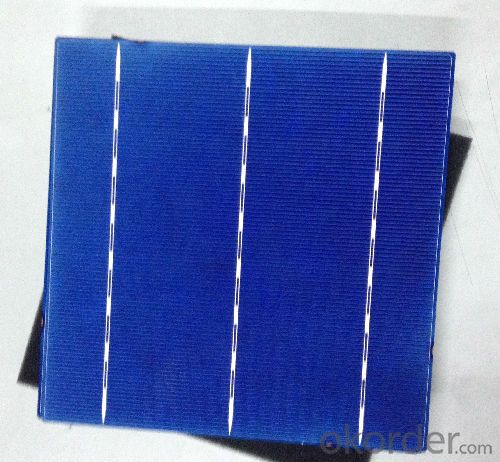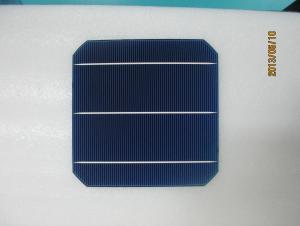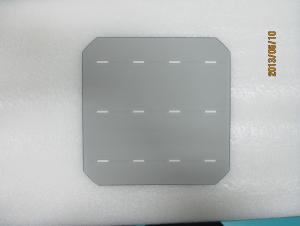156*156MM MONOCRYSTAL SOLAR CELL WITH HIGH EFFICIENCY
- Loading Port:
- Shanghai
- Payment Terms:
- TT or LC
- Min Order Qty:
- 1000 PCS
- Supply Capability:
- 20000000 PCS/month
OKorder Service Pledge
OKorder Financial Service
You Might Also Like
HIGH EFFICIENCY MONOCRYSTAL SOLAR CELL (156*156MM)
Product Description:
Format: 156mmX15mm + 0.5mm
Thickness: 210 mm ±40 mm
Front (-): 1.5mm bus bars (silver),blue anti-reflection coating (silicon nitride)
Back (+): 2.5mm wide soldering pads (silver) back surface field (aluminum)
Efficiency (%) | Pmpp (W) | Umpp (V) | Impp (A) | Voc (V) | Isc (A) |
18.00% | 4.38 | 0.528 | 8.291 | 0.631 | 8.869 |
Main Product Features:
Product Images:


Product Specifications:
Minimum Order Quantity: | 1000 PCS | Unit: | PCS | Loading Port: | Shanghai |
Supply Ability: | 20000000 PCS/month | Payment Terms: | TT or LC |
FAQ:
Q1: Why buy Materials & Equipment from OKorder.com?
A1: All products offered by OKorder.com are carefully selected from China's most reliable manufacturing enterprises. Through its ISO certifications, OKorder.com adheres to the highest standards and a commitment to supply chain safety and customer satisfaction.
Q2: How do we guarantee the quality of our products?
A2: We have established an advanced quality management system which conducts strict quality tests at every step, from raw materials to the final product. At the same time, we provide extensive follow-up service assurances as required.
Q3: How soon can we receive the product after purchase?
A3: Within three days of placing an order, we will begin production. The specific shipping date is dependent upon international and government factors, but is typically 7 to 10 workdays.
Q4: What about payment term?
A4: We accept 30% T/T in advance, with the balance before shipment. L/C at sight is also acceptable. Other payment term can be discussed with specific orders.
- Q:Can solar cells be used for portable devices?
- Yes, solar cells can be used for portable devices. They are commonly used in small electronic gadgets such as smartphones, tablets, and portable chargers to harness solar energy and convert it into electrical power. This enables the devices to be charged or powered by sunlight, making them convenient and environmentally-friendly options for on-the-go usage.
- Q:Can solar cells be used on vehicles other than cars?
- Yes, solar cells can be used on vehicles other than cars. Solar cells can be integrated into various types of vehicles including buses, motorcycles, bicycles, boats, and even spacecraft. The energy generated by solar cells can be used to power the vehicle's electrical systems, reduce reliance on fossil fuels, and contribute to a more sustainable transportation infrastructure.
- Q:How do solar cells handle high winds or hurricanes?
- Solar cells are designed to withstand high winds and hurricanes due to their robust construction and installation techniques. The panels are securely anchored to rooftops or mounted on sturdy frames, ensuring they can withstand strong winds. Additionally, solar panels are tested and rated for wind resistance, with most systems being rated to withstand wind speeds of up to 140 miles per hour. Therefore, solar cells are designed to handle high winds and hurricanes with minimal damage or risk of detachment.
- Q:Can solar cells be used in educational institutions?
- Yes, solar cells can be used in educational institutions. They offer a hands-on approach to teaching students about renewable energy and the importance of sustainable practices. By installing solar panels on rooftops or in designated areas, educational institutions can generate clean energy, reduce their carbon footprint, and save on electricity costs. Additionally, incorporating solar cells into the curriculum allows students to understand the science, technology, and environmental aspects of solar energy, fostering a greater awareness and understanding of renewable energy sources.
- Q:Can solar cells be used for lighting?
- Yes, solar cells can be used for lighting. Solar cells convert sunlight into electricity, which can be used to power lighting systems. This can be done by directly connecting the solar cells to the lighting fixtures or by storing the generated electricity in batteries for later use. Solar-powered lighting systems are environmentally friendly and can be a cost-effective solution for outdoor lighting, street lighting, and even indoor lighting in areas with limited access to electricity.
- Q:What is the effect of shading on solar cell performance?
- The effect of shading on solar cell performance is significant as it can substantially reduce the overall power output of the solar panel. When even a small portion of the solar cell is shaded, it creates a bottleneck for the flow of current, which can lead to a decrease in the voltage and current output. Shading can cause hotspots to form on the shaded cells, resulting in potential damage or reduced efficiency. Therefore, it is crucial to minimize shading on solar panels to maximize their performance and overall energy generation.
- Q:How do solar cells perform in dusty environments?
- Solar cells performance in dusty environments can be significantly affected. The accumulation of dust on the surface of the cells reduces the amount of sunlight reaching the cells, leading to a decrease in their efficiency. Regular cleaning and maintenance are required to ensure optimal performance in such conditions.
- Q:How do solar cells perform in areas with high levels of snowfall?
- Solar cells typically do not perform optimally in areas with high levels of snowfall. The accumulation of snow on the surface of the cells can block sunlight and reduce their efficiency. However, advancements have been made to design solar panels with self-cleaning features or tilted angles that can help shed snow. Additionally, regular maintenance and clearing of snow can help ensure the continued performance of solar cells in such areas.
- Q:How are solar cells tested for quality?
- Solar cells are tested for quality through a series of rigorous evaluations and inspections. These tests typically involve measuring the electrical performance, efficiency, and durability of the cells. They are subjected to various environmental conditions, such as extreme temperatures and humidity, to ensure they can withstand different climates. Additionally, visual inspections are conducted to check for any manufacturing defects or physical damages. Overall, these quality tests help determine if the solar cells meet the required standards for optimal performance and reliability.
- Q:Can solar cells be installed on any type of roof?
- Yes, solar cells can be installed on almost any type of roof, including flat roofs, sloped roofs, metal roofs, tile roofs, and even asphalt shingle roofs. However, the specific installation process may vary depending on the type of roof and its structural integrity. It is always recommended to consult with a professional solar installer to assess the feasibility of installation on a particular roof type.
1. Manufacturer Overview |
|
|---|---|
| Location | |
| Year Established | |
| Annual Output Value | |
| Main Markets | |
| Company Certifications | |
2. Manufacturer Certificates |
|
|---|---|
| a) Certification Name | |
| Range | |
| Reference | |
| Validity Period | |
3. Manufacturer Capability |
|
|---|---|
| a)Trade Capacity | |
| Nearest Port | |
| Export Percentage | |
| No.of Employees in Trade Department | |
| Language Spoken: | |
| b)Factory Information | |
| Factory Size: | |
| No. of Production Lines | |
| Contract Manufacturing | |
| Product Price Range | |
Send your message to us
156*156MM MONOCRYSTAL SOLAR CELL WITH HIGH EFFICIENCY
- Loading Port:
- Shanghai
- Payment Terms:
- TT or LC
- Min Order Qty:
- 1000 PCS
- Supply Capability:
- 20000000 PCS/month
OKorder Service Pledge
OKorder Financial Service
Similar products
New products
Hot products
Related keywords



























